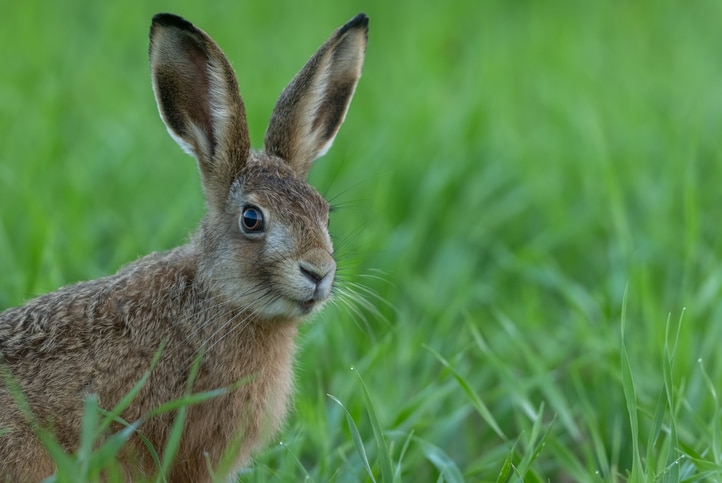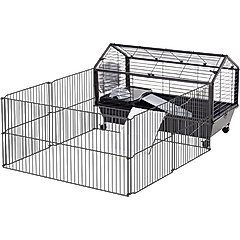Hare vs. Rabbit: How Are They Different and How Are They Similar?

Photo by Andyworks / E+
The hare vs. rabbit question can be so confusing—aren’t they basically the same animal?
Both rabbits and hares have big, floppy ears; soft fur; and an adorable hop. With all their similarities, how different can they really be?
As it turns out, the differences between hares and rabbits are significant. They’re completely different animals with totally different habitats, behaviors, and history.
Read on to understand what exactly makes a rabbit a rabbit and a hare a hare—so you can tell them apart the next time you need to drop some lagomorph knowledge on your friends at trivia night.
What Is a Rabbit?
With their floppy ears and cute, fluffy tails, our timid rabbit friends are those undeniably adorable little creatures we typically find hopping around our neighborhoods or living as beloved pets.
Small and docile, these shy vegetarians have been living near or with humans for thousands of years. With their big eyes, soft ears, and velvety fur, it’s easy to see why so many people enjoy having rabbits as pets.
Rabbits are born blind, deaf, and hairless—they are completely helpless for the first week or so after birth.
While domesticated rabbits (those raised to live alongside humans) usually live indoors or in enclosures, rabbits in the wild (like the cottontail bunnies you might see in your yard) make nests for their young by creating small depressions in the ground to line with fur.
Baby rabbits (known as kits) will leave their nest after three weeks.
The habitats of their bunny cousins across the pond are a little different. European rabbits are very social creatures who live in groups. These groups of rabbits dig burrows to form extensive underground tunnels for entire families of rabbits to call home. Also called warrens, these tunnel homes offer shelter and protection from predators.
Recommended Products
What Is a Hare?
Often confused with rabbits, hares are also members of the order Lagomorpha, but with some key differences.
The most obvious is their appearance—hares are larger than rabbits and have longer ears and hind legs. Their long legs help them move quickly in the wild, and while their fluffy tails and soft fur might seem rabbit-like in nature, hares are wild animals that have never been domesticated.
Unlike our sociable bunny friends, hares—who are also known as jackrabbits in some places—also tend to be more solitary.
These wild creatures are found in open fields, grasslands, and forests. They don’t dig burrows, instead scraping the ground to create small depressions (called “forms” or “scrapes”) where they rest and hide from predators.
Because they have never been domesticated, hares are not kept as pets and don’t live near humans like rabbits do.
María Juárez Byrd, DVM, an exotic and small animal veterinarian at Exotic Health & Husbandry, in Jefferson City, Missouri, explains that domestication of animals can take thousands of years.
Over time, animals are selected to breed and change for human purposes, including behavior and temperament traits.
“Domestication changes the way the brain develops, resulting in animals that are less stressed around people and who have longer juvenile periods to promote adaptability and sociability,” she says. “Because of this, wild animals [such as hares] make bad pets . . . [and would be] very stressed and unhappy if kept as pets.”
Differences Between Rabbits and Hares
Rabbits are more social and prefer small groups, while hares tend to live alone or in pairs.
Sandra Mitchell, DVM, DABVP, owner of All Creatures Veterinary Services, in Eddington, Maine, points to their social nature as one reason why rabbits have been easier to tame as pets than hares, who are more solitary and skittish.
“In the right home dedicated to their well-being, rabbits make delightful pets with different personalities—some being playful, others being cuddly, some being shy,” Dr. Mitchell explains.
By design, hares are built to be excellent runners. Dr. Mitchell says their long, heavy legs are made to escape predators, another reason why they’re harder to domesticate.
As the larger of the two, hares have longer ears, as well as muscular hind legs suited to quick escapes. Their fur might change color throughout the year to camouflage them with the changing of the seasons (for example, white in winter), while rabbits stay the same color throughout the year.
Hares also live above ground, unlike (some) rabbits who burrow. Both are herbivores, but as any gardener can tell you, rabbits love to eat softer foods like grasses and leafy plants. Hares, on the other hand, will also eat tougher vegetation, including bark or twigs.
Although they do have many similarities, rabbits and hares are completely different species of animals and therefore cannot breed with one another.
“Much like cats and dogs can’t have babies together, hares and rabbits don’t have the biologic ability to breed because the egg and sperm are not compatible,” says Dr. Byrd.
They each have a very different start to life, too. As discussed previously, rabbits are born blind, hairless, and helpless—a far cry from their hare cousins. Hares are born fully furred, with open eyes, and can move shortly after birth.
Similarities Between Rabbits and Hares
Despite their differences, rabbits and hares share many traits, including:
- Family ties: Both belong to the Leporidae family and eat plants.
- Physical features: Both have long ears and powerful hind legs that help them move quickly and avoid predators.
- Behavioral traits: Both are prey animals, meaning they’re cautious and very alert to threats nearby. Both tend to be more active at dusk and dawn.
- Importance to their ecosystem: Both rabbits and hares play crucial roles in their environment as prey species and as grazers who help maintain plant diversity.
Hare vs. Rabbit FAQs
Q: Are a hare and a rabbit the same thing?
A: Nope! While they might have similarities, hares and rabbits are two different animals.
Dr. Mitchell points out that some breeds of rabbits (such as the Belgian Hare) have been bred to have the larger, “leggier” look of the hare, but despite what their name says, they are still just rabbits.
Q: Are hares technically rabbits?
A: No, hares are their own animal. Both rabbits and hares are separate species who belong to the same family, Leporidae.
Q: Can rabbits breed with hares?
A: No, rabbits and hares can’t breed together.
While both rabbits and hares are part of the same Leporidae family, they are from different species.
As a comparison, both cats and dogs are members of the Carnivora family, but they can’t breed with one another, as they are completely different species.







